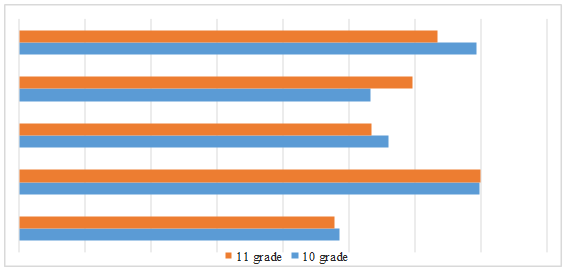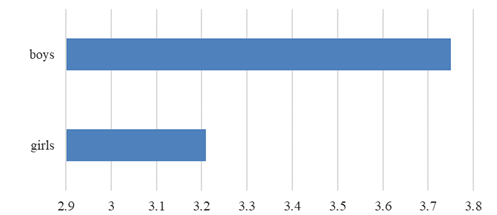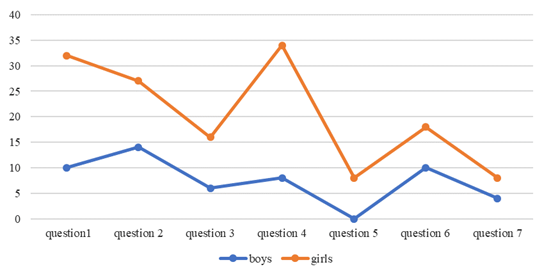Abstract
In adolescence, the solution to the problem of professional self-determination involves making plans for the future and relating them to the present in a time perspective. Young people’s visions of their future give personal meaning to the motivations for their educational activities and social activism. How do young people today see their future? To what extent is the image of the future determined by gender stereotypes and attitudes, educational level, region of residence? Research Objective To conduct empirical studies of personal preparedness for professional self-determination. Sample characteristics 160 boys and girls living in industrial regions and Moscow. Research methodsStanford Time Perspective Questionnaire P. Zimbardo (ZTPI), Problematic Questionnaire. It was concluded that the current early adolescence (16-18 years) is characterized by a contradiction between the aspiration to the future as the most important age pattern and the psychological unwillingness of young people to meet the institutional requirements of adulthood. For today’s high school students, present and future have almost equal value. For school leavers, the future looks less appealing than for the tenth graders, but the anxiety about their future is offset in part by a positive assessment of the past. The findings confirm that there are gender differences in the depth of thinking about the future: boys value their future more than girls.
Keywords: Professional self-determination, social development situation, time perspective
Introduction
In adolescence, the solution to the problem of professional self-determination involves making plans for the future and relating them to the present, taking into account the time horizon (Danilova, 2019; Polivanova, 2016; Puchkova et al, 2019; Petrikova, 2020).
The attitude to time in Russian psychology is represented in several aspects: socialistic as a world image; group, time-reflection in different social groups; interpersonal, the temporary structure of interpersonal interaction is considered; In-person, as a social identity, as an autobiographical memory, social and psychological aspects of the development of an individual chronotop. The image of the future is inextricably linked to the psychological perspective, that is, the ability to visualize yourself in the future (Bentley et al., 2019; Snegova & Maltseva 2019; Timasheva & Nabiullina, 2017). Abulhanova-Slavskaya (1991) emphasizes the different orientation of the psychological perspective in youth:
For some, ideas about the future relate to professional choices, for others, to personal aspirations and future achievements (successful careers), and for others, to personal aspirations and needs (friendship, love, family). These differences are related to the values orientations preferred by spheres of life (p. 144).
Problem Statement
Although the problem of time perspective has been studied for many years, time perspective studies remain relevant. There is not enough research in domestic and foreign psychology to study the age-specific temporal perspective of the individual and to cover the age periods from adolescence to late adulthood.
Research Questions
- How do young people today see their future?
- To what extent is the image of the future determined by gender stereotypes and attitudes, educational level, region of residence?
Purpose of the Study
Conduct an empirical study of personal indicators of readiness for professional self-determination: young people’s perceptions of their future, a time perspective.
Research Methods
The study was carried out in 2018-2020 on the basis of general education schools in Odintsovo, Moscow oblast, and educational institutions in the Ural Economic District (general education schools in Orsk, Orenburg oblast, Chelyabinsk).
The study involved 160 pupils in grades 10-11 (60 boys and 100 girls). Research methodologies were used to obtain relevant empirical data:
The Stanford Time Perspective Questionnaire, P. Zimbardo (ZTPI), was used to study temporal perspective, aimed at assessing the subject’s relationship to time, and through it, at assessing the individual’s relationship to reality, to himself, to his past, present and future.
Seiffqe-Krenke questionnaire, "Problem questionnaire", allows to get a quantitative indicator of the state of experience of the future as a problem.
The resulting data have been processed using descriptive and mathematical statistical methods (the Student t-criterion).
Findings
The Stanford Time Perspective Questionnaire P. Zimbardo (ZTPI) was used to study temporal perspective, aimed at assessing the subject’s relationship to time, and through it, at assessing the individual’s relationship to reality, to himself, to his past, present and future. It contains five scales - negative past, hedonistic present, future, positive past, fatalistic present, attitude on a scale of 1 to 5.
An examination of the time horizon yielded average values for the scales.
The results are interpreted in the context of the overall level of orientation towards the future, the existence of certain plans, the pursuit of objectives, the expectation of success.
For our respondents in grades 10-11 of general education schools, the average minimum values for all scales are in the range of 1.33-2.65 points, the average maximum is in the range of 3.56-4.89 points, and the average is in the range of 2.7-3.6 points (Petrova, 2019).
The time perspective profile of students in grades 10-11 on average scales is presented in Figure 1.

The profile of the time perspective of high school students, as a percentage of pupils in grades 10 and 11, is presented in table 1.
For high school students, the hedonic present is the most appealing, i.e., the desire to extend the current comfortable period of their lives, although group values on this scale do not exceed the average. The future turns out to be equally appealing to tenth graders, but already the eleventh graders rate it slightly lower. An important parameter is the assessment of the fatalistic present: high values on this scale indicate a lack of focused time perspective, a sense of predetermined future, weakness of future goals. Grade 10 and grade 11 group scores on this scale are at the lower end of the middle level, which can be seen as a projection of moderate anxiety and uncertainty about the well-being of life plans.
Retrospect, the value of the past, is the least appealing to high school students, although for the eleventh graders, there is a growing significance to the positive past associated with nostalgic feelings about a past of carefree and understandable life. There are many nostalgic moments, positive, vivid emotional experiences, in a person’s thoughts about his positive past. Nostalgic experiences act as a means of self-regulating emotional states associated with an anxiety experience, facilitating the choice of adaptive coping strategies (Konshina et al., 2018). In general, we see that for today’s high school students, the present and the future have almost equal value. These results coincide with the findings of Sergomanov et al. (2020). Unlike today’s young men and women, half of Soviet high school students preferred to think about themselves, to see themselves as adults. "Stay" at his age wanted 25.4% of schoolchildren, and 24.6% "aspired" to return to the carefree "childhood". This profile was interpreted as aspiration to the future, an early sense of maturity. Only a quarter of Soviet teenagers were comfortable at their age and another quarter were subjectively younger than their age. The empirical evidence obtained from different samples of respondents suggests that, for today’s youth, aspirations for the future are balanced by the high value of the present (Prygin et al., 1987). A number of studies have also shown the predominance of hedonic present orientation in the senior school and youth age (17-20 years) and in the future among students and young adults (21-30 years). There is also evidence that orientation towards the hedonic present is more common among high school girls than boys. Our findings confirm the gender differences in the depth of our thinking about the future. For example, among our respondents, boys rate their future significantly higher than girls (the difference is accurate at p≤0.01 according to the Manna-Whitney U-test criterion; Fig. 2).

Although, in general, the value of the future is not very high for boys, it is still significantly higher than for girls. In addition, we have noted above that boys are much more likely than girls to talk about the distant future, trying to imagine themselves in 10 to 20 years. Golovaha (2000) also notes that girls in all spheres of life expect achievements at an earlier age than boys, their life prospects are not always adequate to the real circumstances, which shows their lack of preparedness for the real problems of adult life. We assume that girls, unlike boys, do not consider professional self-realization as the only option. The modern digital economy does not need as many workers as the industrial one, so girls allow themselves a non-traditional way of realizing themselves - family and motherhood. Research shows that men and women have very different ideas about the future. Men are more likely to identify political, professional and social topics, while women are more likely to refer to topics from the private sphere.
However, the socially desirable vision of the future is not very optimistic; it contains a fair amount of doubt as to the feasibility of the plans. The experience is such a "unit", in which both what is experienced (environment) and what the subject introduces into this experience are inseparably represented. Bozhovich (2008) describes the importance of studying experiences as follows. In order to understand what effect the environment has on the child and, therefore, how it determines the course of his development, one must understand the nature of the child’s experiences, "the nature of his affective attitude towards the environment" (p. 133).
Seiffqe-Krenke Problem questionnaire allows us to obtain a quantitative indicator of the state of experience of the future as a problem and to validate the results. Every high school student evaluated the significance of the problem on a five-point scale, "This problem concerns me in full" - 5 points; "This problem does not concern me" - 1 point. The data obtained are presented in table 02.
The use of the "Problem questionnaire", showed that the high school students of both regions are disturbed by the fear that they will not be able to get the education they would like, as well as the variety of possible life options and its variability (Bolotova & Khachaturova, 2012). At the same time, the equally low (6) rank received the fear that the choices made would not meet the expectations of the parents. In general, there is a high level of similarity of anxieties and fears about the near future experienced by 16-18-year-old students of the Moscow and Ural regions (Spirim rank correlation coefficient ρ = 0.732, that is, strong direct connection). It can be seen as an age related to the social situation of development and independent of specific living and learning conditions.
According to the results presented in table 3, the objective components of the social situation in the Moscow region are represented by a wide choice of educational institutions, which represents a much greater opportunity for the adolescents of the metropolitan area, Therefore, the uncertainty of the future (3) comes first, because everything is too volatile. In the first place among the modern teenagers of the Ural region, the anxiety related to obtaining the education that would like to have (1). The social situation of the adolescents of the Ural region reflects a lack of confidence in oneself, perhaps fear of passing a single state examination. Our assumption is also supported by the answers to the question "I have a low chance of getting in", which won a third place. The sample of respondents in the Moscow region, however, ranked last.
A summary of gender differences in future experiences is presented in figure 3.

It is noteworthy that these experiences are more common among girls. They often say that the future is too fluid, so it’s hard to choose a profession, decide what to do after graduation. Young people are more concerned with the problem of choice among the many possibilities. This difference reflects both the orientation of boys towards higher life achievements and the readiness of girls for different options of adult life.
Conclusion
The findings of our study lead us to the following conclusions.
It was concluded that the current early adolescence (16-18 years) is characterized by a contradiction between the aspiration to the future, as the most important age pattern, and the psychological unwillingness of young people to meet the institutional requirements of adulthood.
For today’s high school students, present and future have almost equal value. At the same time, the high degree of uncertainty of the future in today’s world increases the value of the present for young people, virtually equalling its importance. The balance between the desire for the future and the value of the present is defined as a coping strategy to overcome the difficulties of youth self-determination.
The findings confirm that there are gender differences in the depth of thinking about the future: boys value their future more than girls. The majority of the girls are currently oriented.
References
Abulhanova-Slavskaya, K. A. (1991). Strategiya zhizni [Strategy of life]. Mysl [in Russ.]
Bolotova, A. K., & Khachaturova, M. R. (2012). Chelovek i vremya v situaciyah vybora sovladayushchego povedeniya [Man and time in situations of matching behavior]. Cultural and historical psychology. 1, 69-76 [in Rus.]
Bentley, S. V., Peters, K. S., Haslam, A., & Greenaway, K. H. (2019). Construction at Work: Multiple Identities Scaffold Professional Identity Development in Academia. Frontiers in Psychology, 10. DOI: 10.3389/fpsyg.2019.00628
Bozhovich, L. I. (2008). Lichnost` i ee formirovanie v detskom vozraste [Personality and its formation in childhood]. Peter. [in Russ.]
Danilova, E. E. (2019). Osobennosti predstavlenij o budushchem svoih detej u roditelej starshih doshkol'nikov i starsheklassnikov [Parents of Senior Preschoolers and High School Students have special ideas about the future of their children.]. Humanitarian Scientific Bulletin. 5, 9-15 http://naukavestnik.ru/doc/gv1905Danilova.pdf [inRus.]
Golovaha, E. I. (2000). ZHiznennaya perspektiva i cennostnye orientacii lichnosti [Life perspective and value orientations of personality]. Personality psychology in works of native psychologists (pp. 256 – 269). Peter. [in Rus.]
Konshina, T. M., Pryazhnikov, N. S., & Sadovnikova, T. Y. (2018). Lichnaja professional'naja perspektiva sovremennyh rossijskih starshih podrostkov: cennostno-smyslovoj aspekt [Personal professional perspective of modern Russian senior teenagers: a value and meaning aspect]. Moscow University Psychology Bulletin. Series 14 Psychology, 3, 37–59. DOI: 10.11621/vsp.2018.03.37 [in Rus.]
Petrikova, N. V. (2020). Povedencheskij aspekt predstavlenij o professional'nom Budushchem i vremennaya orientaciya starsheklassnikov [Behavioral aspect of ideas about professional future and temporary orientation of high school students]. Materials of XXV International symposium "Psychological problems of meaning of life and acme". Moscow: FBNU "Psychological Institute RAO" (pp. 185-188). https://doi.org/10.24411/9999-042A-2020-00021 [in Rus.]
Petrova, V. N. (2019). Obraz budushchego kak prediktor professional'nogo razvitiya [Image of the future as a predictor of professional development]. PhD. Tomsk. [in Russ.]
Polivanova, K. N. (2016). Detstvo v menyayushchemsya mire [Childhood in a changing world]. Modern Foreign Psychology, 5(2), 5-10. http:///psyjournals.ru/files/82357/jmfp_2016_n_2_Polivanova.pdf [in Rus.]
Prygin, G. S., Stepansky, V. I., & Faryutin, V. P. (1987). Vliyanie osobennostej samoregulyacii deyatel`nosti na professional`noe samoopredelenie starsheklassnikov [Influence of the features of self-regulation of activity on the professional self-determination of high school students]. Psychology Issues, 4, 45–51. [in Rus.]
Puchkova, E. B., Temnova, L. V., Sorokoumova, E. A., & Kurnosova, M. G. (2019). Vzaimosvjaz' cennostej i kar'ernyh orientacij sovremennyh podrostkov [Relationship Between Values and Career Orientations in Modern Adolescents]. Psychological Science and Education, 24(5), 27–36. DOI: 10.17759/ pse.2019240503 [in Rus.]
Sergomanov, P. A., Andreyeva, A. D., & Danilova, E. E. (2020). Rossijskie podrostki epohi pozdnego sssr i sovremennogo rossijskogo obshchestva [Russian teenagers of the era of the late USSR and the modern Russian society]. Psychology Issues, 4, 40-54.[in Rus.]
Snegova, Y. V., & Maltseva, S. Y. (2019). Psihologicheskoe issledovanie professional'nyh predpochtenij starsheklassnikov [Psychological study of professional preferences of high school students]. Notes by the Saint Petersburg State Institute of Psychology and Social Work, 32(2), 130–137. [in Rus.]
Timasheva, L. V., & Nabiullina, M. V. (2017). Psihologicheskie usloviya sopryazhennosti predstavlenij o budushchem u starsheklassnikov i ih roditelej na etape samoopredeleniya [Psychological conditions for the convergence of ideas about the future between high school students and their parents in the self-determination phase]. Natural Sciences, 7(1), 49-56. DOI: 10.15688/jvolsu11.2017.1.6 [in Rus.]
Copyright information

This work is licensed under a Creative Commons Attribution-NonCommercial-NoDerivatives 4.0 International License.
About this article
Publication Date
25 June 2021
Article Doi
eBook ISBN
978-1-80296-111-9
Publisher
European Publisher
Volume
112
Print ISBN (optional)
-
Edition Number
1st Edition
Pages
1-436
Subjects
Personality, norm, pathology, behavior, uncertanity, COVID-19
Cite this article as:
Lisichkina, A., Emelyanova, L., & Trushina, I. (2021). The Vision Of The Future For Modern Older Adolescents. In M. Ovchinnikov, I. Trushina, E. Zabelina, & S. Kurnosova (Eds.), Personality in Norm and in Pathology, vol 112. European Proceedings of Social and Behavioural Sciences (pp. 229-236). European Publisher. https://doi.org/10.15405/epsbs.2021.06.04.27

